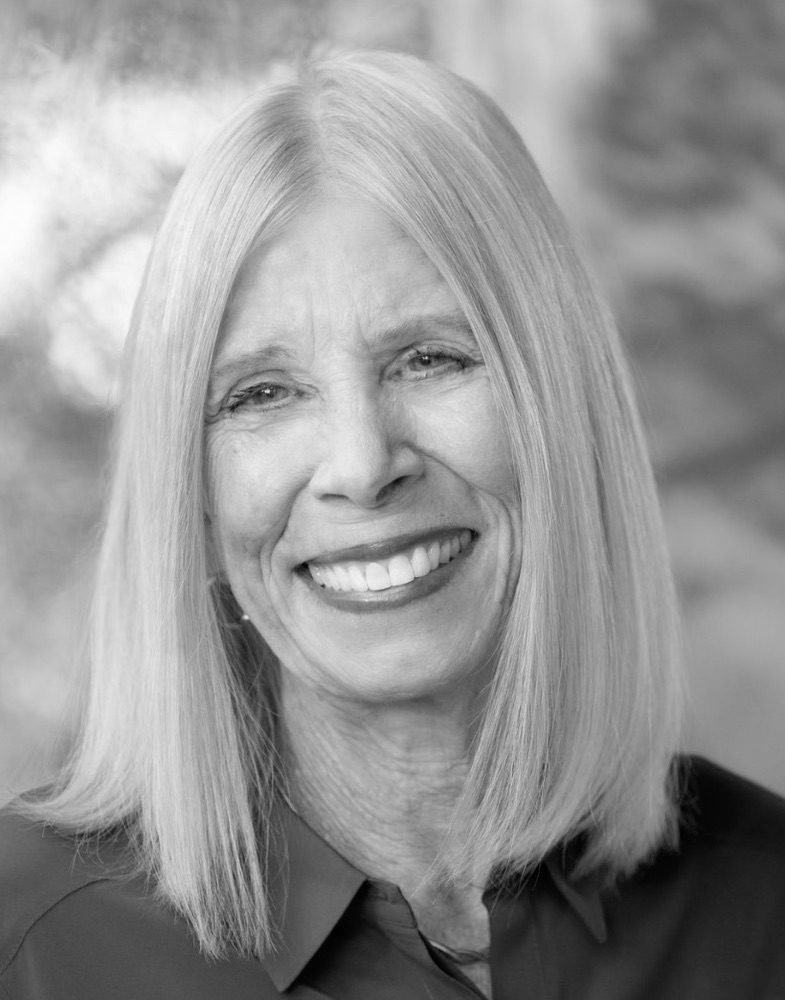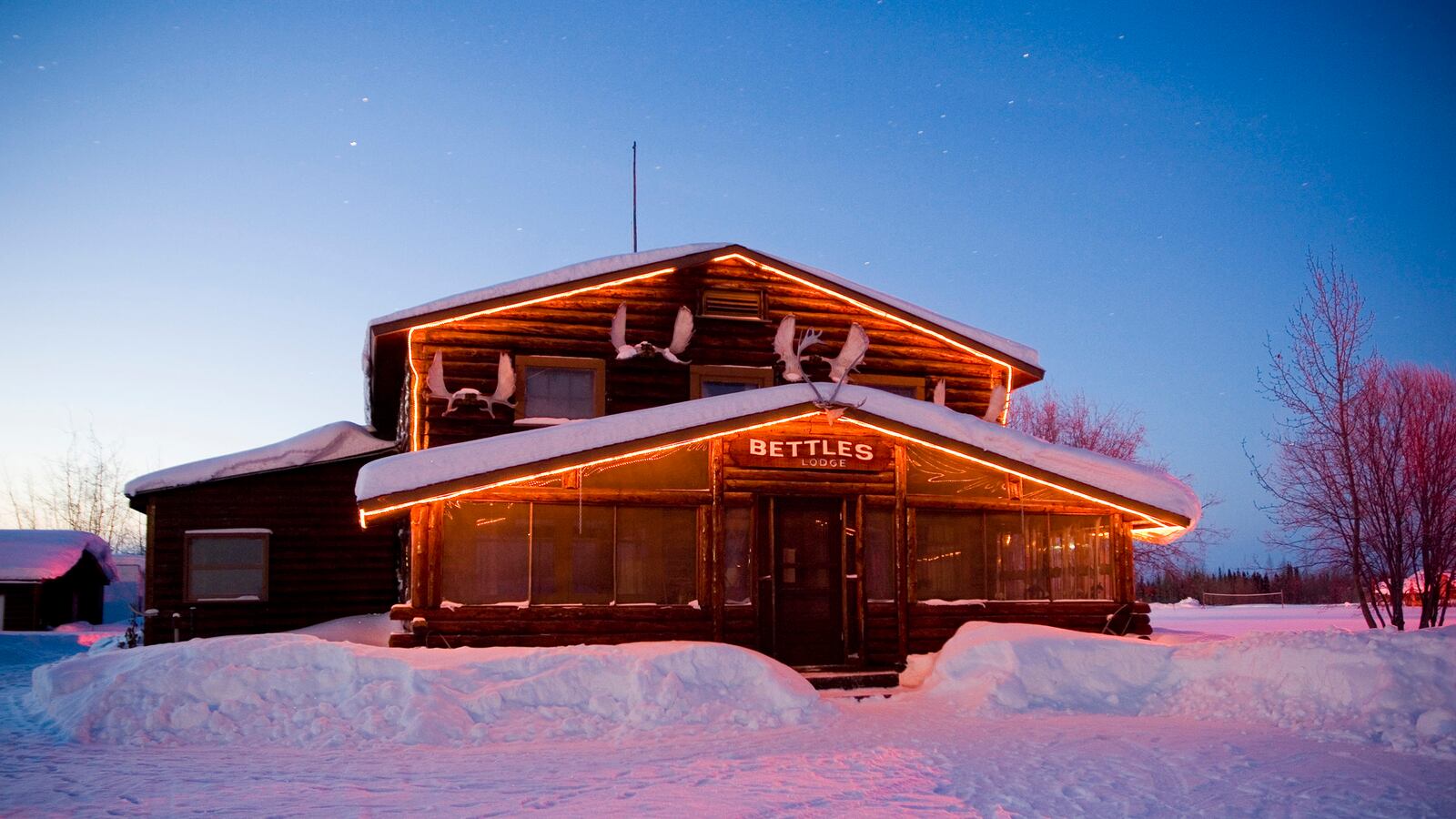On a January morning, at a small airport in Fairbanks, Alaska, I stood in line with a handful of “arctic travelers,” who, like me, wore layers of clothes beneath their heavy jackets and snow pants. We were a bit overdressed for our trip north of the Arctic Circle. I had expected Alaska to be miserably cold, with howling winds and fierce storms. Instead, the Polar Vortex had gone schizoid; the East Coast was digging out of Winter Storm Janus while the folks in Fairbanks were in the midst of what they considered hot weather—25 to 35 degrees above zero.

One by one we tourists lumbered onto a baggage scale and were weighed, right along with our luggage and the tightly taped cardboard boxes packed with groceries from Fred Meyer and Safeway. These grocery boxes fulfilled orders that had been faxed in from Alaskans in the bush who paid dearly for food from the bigger cities, which, I had been told, could reach as high as $19 for a head of cabbage.
And that's where my husband Walt and I were headed—to the remote land of $19 cabbages via a bush plane. We were bound for Bettles, Alaska, which sits 35 miles north of the Arctic Circle and has a current population of 15 people.
As the bush plane flies, Bettles is about 180 miles northwest of Fairbanks. From August to April, the tiny village attracts a small group of diehard Northern-Lights watchers—Bettles is tucked beneath an “auroral band” that's easy to see, thanks to the lack of light pollution. In the summer, though, Bettles sees more tourists who come to the fly-and-mosquito infested gateway into the Alaskan wilderness. Savvy hikers, hunters, kayakers and anglers use the village as a starting and ending point for expeditions into Gates of the Arctic National Park and Preserve, the Brooks Range, or one of the other tundra, boreal forest, wild river, or lake destinations.
Bettles also attracts year-round climate-change tourists like me. The Arctic is warming twice as fast as other parts of the world with measurable consequences. The day before I headed off to Bettles, I had met with scientists based at the University of Alaska Fairbanks who have monitored and mapped the effects of climate change in the Arctic for years. While those of us in the Lower 48 grapple with extreme storms and droughts that many climatologists believe are linked to the warming of the Arctic, Alaskans cope with a different set of climate-change problems: fires on the tundra; longer, buggier summers; changing river hydrology; higher energy costs; vanishing lakes; and less accessibility to game, a critical protein source given the price of Angus sirloin in the bush. Remote villages are losing people for all these reasons, plus the fact that Alaskan kids have iPhones too, and many are choosing to live elsewhere when they grow up. While climatologists were warning that this winter’s freaky weather likely had little to do with climate change, which is measured over the long haul, some climate change models suggest that we will reach the point-of-no-return in global warming within decades. I wanted to experience the fragile Alaskan Arctic before it becomes something else.
The frozen Yukon River, snaking its way to the Bering Sea, was visible from my window on the Cessna. Alaskans are fond of saying you can't comprehend the scale of the place unless you fly over it. They're right. Alaska covers 570,640 square miles of big, rugged country. The 2010 census counted 710,231 people in the entire state. The landscape is immense—rivers, hills, flatlands, jagged mountains. Dark green boreal forests fanning into white tundra. Sky and soft sunlight tint the snow blue, pink, lilac, peach.
For parts of the hour-long flight, I could see the Dalton Highway, a 414-mile gravel road that connects Fairbanks to the North Slope oil fields. The Dalton Highway is one of the settings for the History Channel’s reality series, Ice Road Truckers. Assuming you have the provisions, gear, and vehicle to survive double-digit, subzero arctic weather, you can turn off the Dalton Highway and drive on an ice road to Bettles. The road, however, can be unreliable. It’s not open all the time in winter and melts after the spring thaw, vanishing into bogs and rivers.
So, bush planes are Alaska's airborne beasts of burden; they've shuttled people, animals, vehicles, mail, and supplies in and out of the interior for decades. They're the preferred, and often the only, available transportation from urban hubs, like Fairbanks and Anchorage, to remote villages. But bush-plane safety records have long been controversial. And scary. In 2013, for instance, the National Transportation Safety Board documented 92 aviation accidents in Alaska, and 35 people died. And that was a relatively safe year.
The Cessna landed like a feather on Bettles Field, a long, flat airstrip built by the Navy during World War II. With relatively clear weather, the area was a good stopover for military planes heading to and from the North Slope, which was reserved by the U.S. government for “military purposes” and oil exploration. After World War II ended, the government maintained a weather monitoring station in Bettles, and the airfield became a way station for bush planes tasked with servicing remote areas of the Arctic. In 1950, a bush pilot named Andy Anderson and his Alaskan native wife, Hannah, built the Bettles Lodge on the edge of the Bettles Field tarmac. While the lodge has changed hands a couple of times since, it’s now on the National Register of Historic Places. The small, two-story wooden structure still greets visitors as they stumble out of the bush planes.
I stepped out of the bush plane to find everything swathed in granular snow; it all looked like a peaceful Christmas card to me. New to the Arctic, I was struck by the immense quiet of the empty, icy wilderness that surrounds Bettles. The village sits on flat land near the frozen Koyukuk River, and looks out on snowy hills. To the north, the icy southern peaks of the Brooks Range, the northernmost mountain range on the continent, nip at the sky. What struck me immediately was the lack of discernable scents. I couldn't smell the dwarfed spruce trees. I couldn't smell the frozen Koyukuk. It was all so clean and cold, it was odorless.
But I apparently wasn’t. On my first day in Bettles, I was christened by a curious Alaskan Husky that sniffed my leg and then urinated on it. I washed my snow pants at the Aurora Lodge, where we had booked a room for three nights. The same people who now own the Bettles Lodge own the Aurora Lodge, which is a bit more modern and is toasty warm. It's not fancy, consisting of a small kitchen, living room and dining room, and a hallway of modest bedrooms with rustic furniture. In the furnace room, the lodge stores “Arctic Gear”—snow pants, jackets, mittens, face masks, and those famous whitish rubber military surplus “bunny boots” that appear to be of World War II vintage—for those guests who might arrive underdressed.
The beauty of Bettles and Evansville, a native village that sits right next to Bettles, with their combined population of 28 people, is that you can safely immerse yourself in the Arctic just by dressing warmly and slipping into the lodge's free cross-country skis, snowshoes, or bunny boots for a walk down the road connecting the villages. Downtown Bettles consists primarily of the lodge (there's another hotel, but it was closed for the season) the airstrip, a Gates of the Arctic National Park office with windows covered by slabs of pink insulation, a post office, and the old Federal Aviation Administration weather station that's still measuring Bettles weather, which ranges from extremes of 70 below zero to the muggy 80s and an occasional 90-degree day in the summer.
As luck would have it, we avoided those arctic storms with shrieking winds. There was no wind at all during our three-day stay in Bettles, and everyone I talked to in Bettles felt the temperatures were unseasonably warm. Mayor Gardner cancelled a caribou-chili dinner party because a kitchen pipe exploded—a catastrophe that she said usually happens in the spring. Originally from Colorado, Gardner is a ranger for Gates of the Arctic National Park, which she calls “black belt wilderness”—one of the most pristine, road-free undeveloped tracts of land on the planet.
Gates of the Arctic was closed for the season when I was in Bettles, but the locals know you don't have to go to a national park to witness climate change. Hannah Anderson told me the Koyukuk River has changed since she was a girl. It's less predictable and seems to have less water. Mayor Gardner noted that a lake that had served as a summer breeding ground for migratory cranes recently disappeared. The reason: frozen permafrost that once contained the lake water (like cement contains a swimming pool) had melted. As a result, the water sank into the ground, prompting migratory cranes to issue calls of “grief and bewilderment.”
Gary Hanchett is 68 years old and the vice-mayor of Bettles. He, too, says the climate is changing. Among other things, the ice storms have become increasingly “monstrous.”
He's often out in the big country for one of his many part-time jobs: subsistence resource manager, backup postmaster, installer of satellite dishes, elections worker, air-quality monitoring station employee, tour guide (via snowmobile in the winter and boat in the summer), maintenance man, school bus driver, operator of a road grader, receptionist, and fur trapper. He said the Arctic keeps him “alive,” and he's tied to it because it “is the way it is.” He would hate to see it change, not only by the climate, but also by future planned mineral development that promise to bring roads into the interior, carving up the wilderness so “it won't be big and beautiful any more.”
I had long looked forward to swooshing across this fragile, expansive Arctic landscape on a dog sled. But when a grim-faced couple, friends and fellow lodge guests, pulled up after their two-hour dog sled adventure, they couldn't wait to climb off. They'd gotten very cold. The dog sled flipped briefly on its side once, which was elbow-banging-no-fun. “And,” our friend in the front sled seat observed, “the dogs farted a lot.”
So it was with some trepidation that Walt and I hopped on a snowmobile and rode a half-mile or so down to the dog pens, where around 30 dogs, mostly Alaskan Huskies along with a few arctic mutts, were chained near their plywood dog houses. The dogs were gentle and happily allowed us to pet them, but clearly they wanted to get on the road.
So did the musher, Jurden Winkelmann, a 26-year-old German social worker taking a break from his career to train sled dogs and hang out with tourists at Bettles. After he'd leashed the huskies up to the sled, Winkelmann deftly zipped me into a tarp-like blanket. Being the smallest person among us, I had the first seat on the sled, the one closest to the dogs. Walt sat above and behind me, and Winkelmann stood behind Walt.
Minky, one of the lead dogs, was in season. This gave the male dogs behind her an extra incentive to follow. And so we soared off. The dogs yipped and barked. Like Santa Claus calling “On Vixen!” Winkelmann called out to various animals from time to time: “Tennis!” “Ootok!” “Cyclone!” “Pirate!” “Keshar!” “Swimmer!” “Emil!” “Elise!” “Spears!” “Devil!”
We scooted along at about 10 miles an hour. The huskies panted and loped. The sled swished over snow.
I was sitting so low, even the permafrost-stunted spruce trees towered over me. I wondered what would happen to the trees if some of the permafrost melted, allowing roots to expand in longer growing seasons.
After an hour, we sailed across the frozen Koyukuk River. (I admit, given the recent warm weather, crossing the river made me a little anxious.) Winkelmann reined in Minky and pals so we could stretch our legs near “Old Bettles.” It's a ghost town now, just a handful of weathered wooden buildings sagging beneath snow. But in the late 19th century, it was a bustling trading community known as Arctic Village, founded by an Alaska Gold Rush entrepreneur named Gordon Bettles. At the time, steamboats carrying goods and gold miners from Fairbanks could travel up the Koyukuk as far as Gordon Bettles' trading post. But as the decades passed, airplanes replaced steamboats and folks abandoned Old Bettles to live near the airstrip.
The dogs wanted nothing to do with Old Bettles, either. They yapped and pulled at their leads with such energy that Winkelmann insisted we climb back into the sled, pronto. The huskies galloped through the flatlands for another hour before depositing us at the lodge. And honestly, sitting downwind of the dogs, I'd realized my theory of the odorless wintertime Arctic didn't always hold.
Even so, we wanted to climb right back into Winkelmann's sled and immerse ourselves in the quiet blue Arctic for another two hours. The cost, though, was prohibitive—$250 per person per hour.
Back at the Bettles Lodge, we ate a large protein-rich meal along with homemade desserts served with coffee. The calories sustain guests who spend inordinate amounts of time outside, particularly at night, when the Northern Lights are out. In fact, many guests spend most of the night outside.
With a few exceptions, our fellow travelers were mostly sixty-something bucketlisters with expensive cameras, old Boomers taking advantage of cheap winter rates to see the Northern Lights. The most hardy Northern-Lights watchers stood for hours on the airstrip near their tripods, photographing capricious, uneven bands of green light appearing and disappearing in the black night sky.
On our last night in Bettles, at about 11 p.m., six of us positioned ourselves near a “viewing cabin” on a frozen lake two miles from the lodge. The cabin was warm and smelled of heating oil and hot coffee. Mostly, I stayed outside in the bone-chilling cold, adjusting my facemask so I could peer at a wide, white band that arced across the center the sky. Everyone said it was the Milky Way, but suddenly it morphed into a giant explosion of green light so radiant the guys could see the F-stops on their expensive cameras. The auroral band teased and delighted us. We laughed and whooped and clapped and danced and hugged each other. But then, after 15 minutes or so, the enormous band disappeared into the night sky. Smaller bands of green sashayed out again, taking different shapes in unexpected quadrants of blackness. We looked for pink lights, which are farther away from the earth than the green lights, but only the most eagle-eyed could spot them. Finally, at 1 a.m., we returned to the lodge, stiff-necked and jubilant.
The next day, as I packed up for the (uneventful) bush-plane ride back to Fairbanks, I looked out the lodge window at a skeletal spruce tree and the expanse of fragile, snow-covered tundra beyond it. In the summer, I might look out this same window and see one of the last migrating herds of caribou thundering down from the Brooks Range. I was overcome by a sense of loss, and at that moment, I just wanted to figure out how I'd get myself back to the Arctic before it changed on me.






